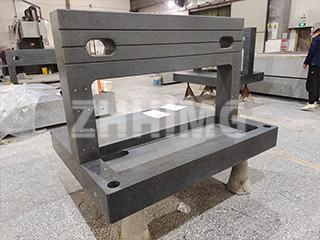Granite precision components are essential reference tools for high-accuracy inspection and measurement. They are widely used in laboratories, quality control, and flatness measurement tasks. These components can be customized with grooves, holes, and slots, including through-holes, strip-shaped holes, threaded holes, T-slots, U-slots, and more. Components with such machining features are generally referred to as granite components, and many non-standard flat plates fall under this category.
With decades of experience in manufacturing granite surface plates, our company has accumulated extensive expertise in the design, production, and maintenance of granite precision components. During the design phase, we carefully consider the operational environment and required accuracy. Our products have proven reliable in high-precision measurement applications, particularly in laboratory-grade inspection setups where stringent flatness and stability standards are required.
According to Chinese national standards, granite components are classified into three accuracy levels: Grade 2, Grade 1, and Grade 0. The raw materials are carefully selected from naturally aged rock formations, ensuring excellent dimensional stability that is minimally affected by temperature variations.
Key Applications of Granite Precision Components
-
Industrial Applications
Granite components are widely used across multiple industries, including electronics, machinery, light industry, and manufacturing. By replacing traditional cast iron plates with granite platforms, and machining holes or T-slots on their surfaces, these components provide versatile and durable solutions for precision tasks. -
Accuracy and Environmental Considerations
The design and accuracy class of a granite component directly influence its suitable usage environment. For example, Grade 1 components can be used under normal room temperatures, while Grade 0 components require a controlled temperature environment. Before high-precision measurements, Grade 0 plates should be placed in a temperature-controlled room for at least 24 hours. -
Material Properties
The granite used for precision components differs significantly from decorative marble or granite used in construction. Typical density values are:
-
Granite surface plate: 2.9–3.1 g/cm³
-
Decorative marble: 2.6–2.8 g/cm³
-
Decorative granite: 2.6–2.8 g/cm³
-
Concrete: 2.4–2.5 g/cm³
Granite surface plates are refined through precision grinding to achieve ideal flatness and surface finish, ensuring long-lasting accuracy.
Advanced Applications: Air-Float Granite Platforms
Granite platforms can also be integrated into air-float systems, forming high-precision measurement platforms. These systems utilize dual-axis gantry structures with air-bearing sliders running along granite guides. Air is supplied through precision filters and pressure regulators, allowing near-frictionless movement. To maintain high flatness and surface quality, granite plates undergo multiple grinding stages with careful selection of grinding plates and abrasives. Environmental factors, such as temperature and vibration, are closely monitored, as they can affect both grinding and measurement outcomes. For instance, measurements performed at room temperature versus controlled temperature environments can show a flatness difference of up to 3 µm.
Conclusion
Granite precision components serve as fundamental inspection tools across various manufacturing and measurement applications. Commonly referred to as granite plates, granite surface plates, or rock plates, these components are ideal reference surfaces for instruments, precision tools, and mechanical part inspection. Despite minor naming differences, they are all made from high-density natural stone, providing stable, long-lasting flat reference surfaces for precision engineering.
Post time: Aug-15-2025

